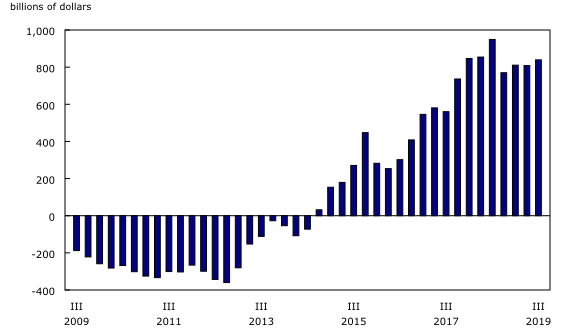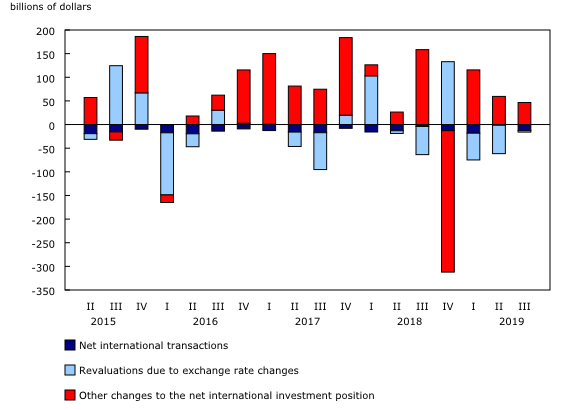Canada's international investment position, third quarter 2019
Archived Content
Information identified as archived is provided for reference, research or recordkeeping purposes. It is not subject to the Government of Canada Web Standards and has not been altered or updated since it was archived. Please "contact us" to request a format other than those available.
Released: 2019-12-12
$839.1 billion
Third quarter 2019
Canada's net foreign asset position increased by $30.6 billion to reach $839.1 billion at the end of the third quarter. The increase was mainly due to higher equity prices. Canada's net foreign asset position represented 36.3% of gross domestic product, up from 35.1% in the second quarter.
Canada's international assets were up by $102.9 billion to reach $5,463.3 billion at the end of the third quarter. The increase was mostly due to the revaluations from higher foreign equity prices. Over the quarter, the US stock market gained 1.2%, and the European stock market increased 2.8%. At the end of the third quarter, 68.5% of Canada's international assets were in the form of equity instruments, compared with 41.7% of its international liabilities.
At the same time, Canada's international liabilities were up $72.4 billion to $4,624.2 billion. This increase largely came from cross-border transactions, mainly on higher foreign holdings of currency and deposits in Canada.
Overall, exchange rate fluctuations had a limited impact on the revaluation of Canada's international assets and liabilities in the third quarter. Over the quarter, the Canadian dollar lost 1.2% against the US dollar and 0.9% against the Japanese yen, but gained 3.1% against the euro and 2.1% against the UK pound sterling.
Canadian financial corporations contribute heavily to Canada's overall net foreign asset position
Overall, Canada is a net creditor to the rest of the world, meaning that its international assets exceed its international liabilities. International assets and liabilities can also be presented on a sector basis, based on the sector of the Canadian economy that owns the asset or owes the liability. Canada's net international investment position paints a fairly different picture when presented by sector.
Canada's overall net foreign asset position with the rest of the world reflects the strong international position of the Canadian financial sector. Financial corporations' net foreign asset position reached $1,707.6 billion at the end of the third quarter, making it a net lender to the rest of the world.
The value of Canadian financial corporations' international assets totalled $3,836.0 billion in the third quarter, while the value of their international liabilities was $2,128.4 billion. Canadian financial corporations are heavily exposed to foreign assets. Overall, they represented 70.2% of all international assets, mainly through holdings of portfolio and direct investment equities. Banks and other financial corporations, such as mutual funds and pension funds, are entities included in the financial sector.
Non-financial corporations are net borrowers of funds from abroad
While the Canadian financial corporate sector records a large excess of international assets over liabilities, the opposite is observed for the non-financial corporate sector. Canadian non-financial corporations' foreign liabilities exceeded their international assets by $789.1 billion at the end of the third quarter.
Foreign markets are an important source of funds for Canadian non-financial corporations. Their international liabilities to the rest of the world reached $1,762.1 billion in the third quarter, while their international assets amounted to $973.0 billion. Liabilities were mainly in the form of equity, held by both foreign direct investors ($794.4 billion) and foreign portfolio investors ($525.9 billion). Non-financial corporations also borrow funds from abroad in the form of debt instruments, mainly on foreign bond markets. At the end of the third quarter, nearly two-fifths (38.1%) of Canada's total international liabilities were owed by this sector of the economy.
Note to readers
This release incorporates new information on the sector composition of Canada's international financial assets and liabilities. The information is presented based on the sector of the Canadian economy that owns the asset or owes the liability. The institutional sectors covered are the non-financial corporations sector, the financial corporations sector (monetary authorities, deposit-taking corporations and other financial corporations), and the general government sector. The households and the non-profit institutions serving households sectors, and assets and liabilities that cannot be allocated to a specific sector, are grouped in the "other sectors" category. Data are available in table 36-10-0593.
Revisions
This release incorporates statistical revisions back to the first quarter of 2012 as part of the annual revision exercise of the Canadian System of Macroeconomic Accounts. Revisions reflect the integration of new data sources. They also reflect improved methodologies mostly impacting market value estimates of Canadian direct investment abroad in non-US countries.
Currency valuation
The value of assets and liabilities denominated in foreign currency is converted to Canadian dollars at the end of each period for which a balance sheet is calculated. When the Canadian dollar is appreciating in value, the restatement of the value of these assets and liabilities in Canadian dollars lowers the recorded value. The opposite is true when the Canadian dollar is depreciating.
Definitions
The international investment position is the value and composition of Canada's assets and liabilities to the rest of the world.
Canada's net international investment position is the difference between Canada's assets and liabilities to the rest of the world. An excess of international liabilities over international assets can be referred to as Canada's net foreign debt. An excess of international assets over international liabilities can be referred to as Canada's net foreign assets.
Foreign direct investment is presented on an asset-liability principle basis (that is, a gross basis) in the international investment position. Foreign direct investment can also be presented on a directional principle basis (that is, a net basis), as shown in supplementary foreign direct investment tables 36-10-0008-01 and 36-10-0009-01. The difference between the two foreign direct investment conceptual presentations resides in the classification of reverse investment such as (1) Canadian affiliates' claims on foreign parents and (2) Canadian parents' liabilities to foreign affiliates. Under the asset–liability presentation, (1) is classified as an asset and included in direct investment assets, and (2) is classified as a liability and included in direct investment liability.
Products
The Economic Accounts Statistics portal, accessible from the subjects module on our website, features an up-to-date portrait of national and provincial economies and their structures.
The article "Currency composition of Canada's international investment position," part of Latest Developments in the Canadian Economic Accounts (13-605-X), is available.
The Methodological Guide: Canadian System of Macroeconomic Accounts (13-607-X) is available.
The User Guide: Canadian System of Macroeconomic Accounts (13-606-G) is also available.
The Canada and the World Statistics Hub (13-609-X) is available online. This product illustrates the nature and extent of Canada's economic and financial relationship with the world through interactive graphs and tables. This product provides easy access to information on trade, investment, employment and travel between Canada and a number of countries, including the United States, the United Kingdom, Mexico, China and Japan.
Contact information
For more information, contact us (toll-free 1-800-263-1136; 514-283-8300; STATCAN.infostats-infostats.STATCAN@canada.ca).
To enquire about the concepts, methods or data quality of this release, contact Vicky Gélinas (613-716-2828; vicky.gelinas@canada.ca), International Accounts and Trade Division.
- Date modified:





